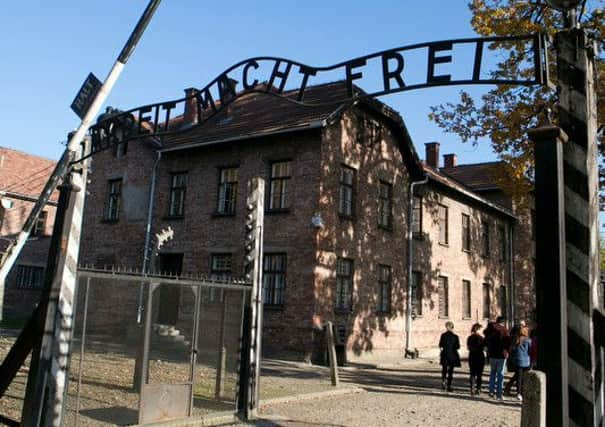Lest we forget - the horrors of Auschwitz


Eight words which determined whether you lived or died — “Men to the left, women to the right.”
Those words exemplify the utter futility and absurdity of the Nazi plan to exterminate the Jewish race.
Advertisement
Hide AdAdvertisement
Hide AdIt’s been 70 years since the liberation of the death camps at Auschwitz-Birkenau, and elsewhere, where six million Jews were butchered mercilessly — including 1.5 million children.


My visit to Poland and Oswiecim, the town where the camps were located, and which translates in German as Auschwitz, was a very sobering one.
The sun was splitting the skies yet there was a pervading darkness, something indescribable, yet still palpable somehow — and I had no idea what it was.
To give the figures some context: before the war, 58 per cent of the population of Oswiecim were Jewish, now there are none. If we were to stand for a minutes silence in memory of all who were murdered we would be standing for two years. That puts into a sobering perspective the Nazi plan to rid Europe of the Jewish race.
Advertisement
Hide AdAdvertisement
Hide AdAuschwitz is actually two sites — Auschwitz One and Auschwitz Two the latter also known as Birkenau — and was the location of the main killing site where the gas chambers and crematoria were located, as well as the largest camp of the two.


Walking around the site, viewing people’s belongings, all looted by their captors, forces you to confront these horrors head on.
The hairbrushes particularly resonated, after all, the glass case filled seven foot high with human hair was testimony as to why they wouldn’t have been needed. People, who were quite literally shaved of the last vestiges of dignity.
The shoes, hundreds, mixed with an assortment of medical aids, false legs all lying silently, yet screaming a message as loud and clear as any — baby shoes cast aside — telling the tale of a life snuffed out far too early. And remember this all took place only 70 years ago.
Advertisement
Hide AdAdvertisement
Hide AdThe Holocaust Educational Trust, with whom I travelled as a guest, along with more than 200 pupils from across Scotland’s senior schools, aims to educate the youth of today in order that the horrors perpetrated by the Nazi regime may never be forgotten.


The truth is, seeing is so much stronger than hearing. You cannot fail to be moved by the visual stimuli on such a visit, which in some respects make the figures so much harder to comprehend.
Ignorance, prejudice and apathy led to 1.1 million Jews being murdered in Auschwitz from a total of 1.25 million held there between May 1942 and October 1944.
It has been said, rightly, that the Holocaust is one of the twentieth century’s defining events; murder on a mass scale which could never happen again — or could it? Darfur, Rwanda and the Balkans are all reminders that we still live in a time when values are constantly changing, cultures still cannot agree or even live in peace.
Advertisement
Hide AdAdvertisement
Hide AdAnd despite the horrors of the Nazi genocide and that it must never be allowed to happen again, there is ample evidence that anti-Semitism, religious hatred and political intolerance still abound.


For me there were many poignant moments through the day, but the lasting memory I took away was watching the sun dip below the horizon as Mother Nature painted the sky with her remarkable palette. And all the while I couldn’t stop thinking how many tortured souls had viewed the same tantalising scene, and for how many was it their last?
Kitty Hart-Moxon - A survivor
While the Nazis had perfected their killing machine with the use of Zyklon B poison (cyanide) and gas chambers, slaughtering hundreds every hour, getting rid of the bodies was a much more difficult problem to overcome.
With the crematoria working at full capacity the use of open fire pits became commonplace.
Advertisement
Hide AdAdvertisement
Hide AdOne survivor who arrived at Birkenau as a teenager, Kitty Hart-Moxon remembered: “The railway line petered out. We kept going until we were halted at another gate and a guardhouse. This was in fact the entrance to Auschwitz II or Birkenau, though at the time we knew nothing of the names or significance.
“A dank chill caught at us. The whole area was shrouded in a clinging grey mist. But dawn was breaking, or was it really the dawn? A reddish glow through the mist was flickering in the weirdest way and there was a sickly, fatty, cloying smell. Mother and I glanced at each other, baffled. Who could be roasting meat, great quantities of it, at this hour of the morning?”
Kitty had just witnessed her first funeral pyre. And these comments from her no better amplify the horror which faced those arriving at the death camps than any I can write.